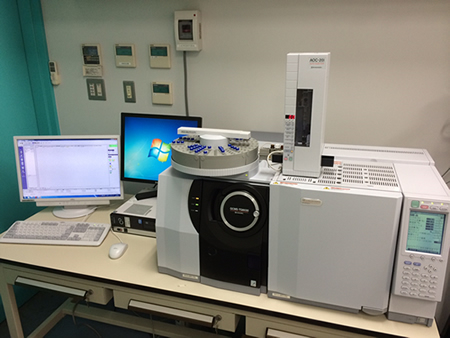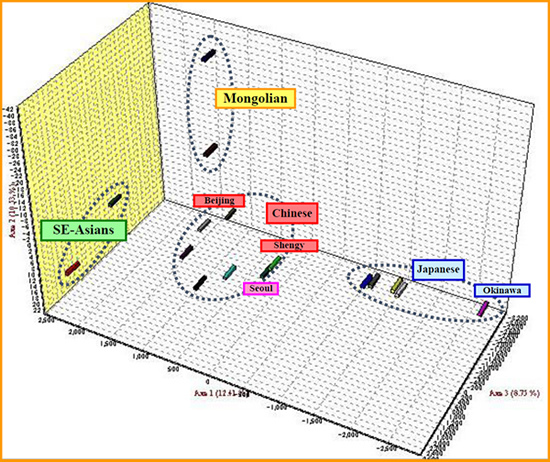Laboratories
- Back
- Top > Laboratories > Social Life Science > Legal Medicine and Bioethics
Social Life ScienceLegal Medicine and Bioethics
Introduction
Forensic medicine is the study of medical matters that are related to the law, covering an extremely wide range of topics.
In our laboratory, we provide expert testimonies in actual caseworks, and further address research challenges that emerge through such practical cases.
In addition to forensic pathology and medical ethics, our laboratory is currently focusing on the following 3 research areas:
- Forensic toxicological studies using various mass spectrometers
- Individual identification methods and population genetics/phylogenics through the use of DNA
- Toxicity mechanism studies through metabolomics of endogenous metabolites
Research Projects
1. Forensic toxicological studies using various mass spectrometers
We are working on high-sensitivity analysis of drugs and poisons within biological specimens using front-line mass spectrometers in our laboratory, such as liquid chromatograph-quadrupole-time-of-flight mass spectrometer (LC-Q-TOFMS, Photo 1), gas chromatograph-tandem mass spectrometer (GC-MS/MS, Photo 2), and liquid chromatograph-tandem mass spectrometer (LC-MS/MS).
We target a wide range of compounds including illegal drugs (i.e. amphetamines and methamphetamines), controlled substances such as synthetic cannabinoids, benzodiazepines, and natural toxins (plant poisons like aconite and marine poisons like tetrodotoxin).
Current research project themes include the development of mass spectral database of natural toxins and the development of isomeric differentiation method of designated substances (i.e. synthetic cannabinoids) using accurate mass analysis, as well as the analysis of first phase metabolic pathway of illegal drugs.
Additionally, one of our recent research themes include the development of simultaneous analysis method of bile acid and the forensic application of bile acid profiles.
Students in our laboratory are expected to learn basic knowledge on mass spectrometry, to operate the mass spectrometers in our lab, and to acquire sample pretreatment skills necessary for instrumental analysis. Some of the research themes involve dose experiments of drugs and poisons on animals, therefore students will also learn basic animal experiment operation procedures.
Current research project themes include the development of mass spectral database of natural toxins and the development of isomeric differentiation method of designated substances (i.e. synthetic cannabinoids) using accurate mass analysis, as well as the analysis of first phase metabolic pathway of illegal drugs.
Additionally, one of our recent research themes include the development of simultaneous analysis method of bile acid and the forensic application of bile acid profiles.
Students in our laboratory are expected to learn basic knowledge on mass spectrometry, to operate the mass spectrometers in our lab, and to acquire sample pretreatment skills necessary for instrumental analysis. Some of the research themes involve dose experiments of drugs and poisons on animals, therefore students will also learn basic animal experiment operation procedures.


Q-TOF mass spectrometer (AB Sciex TT5600) Gas Chromatograph-tandem mass spectrometer (Shimadzu GCMS-TQ8040)
2. Individual identification methods and population genetics/phylogenetics through DNA
Short tandem repeats (STR), mini-satellites, and single nucleotide polymorphism (SNP) are used as markers for individual identification. Our laboratory has been working on innovative detection method methods of low molecular compounds in very trace amounts from forensic and historical evidence materials. Other research focuses include: Japanese database compilation, population genetics using DNA samples from neighboring countries, and phylogenetic studies using primate DNA samples. Our recent researches are involved in the genotyping and post-feeding time estimation using mosquitos after hematophagy, and genome-wide STR analysis of different genetic groups in East Asia.
 Genetic relationship among different groups of East Asia based on genome-wide STR markers
Genetic relationship among different groups of East Asia based on genome-wide STR markers
3.Metabolomics is the systematic study of endogenous metabolites such as amino acids, fatty acids, sugars, and nucleic acids, and is an area of research that has been attracting much attention in the recent years. Having already built a metabolomics platform technology using mass spectrometry, by combining animal (rats and mice) experiment and metabolomics our laboratory aims to unravel the expression mechanisms of acute poisoning deaths due to drugs and poisons, drug dependence of addictive drugs, and pathogenesis of sudden death.
Students will learn basic animal experiment procedures, basic knowledge of mass spectrometry and metabolomics, operation of mass spectrometers used in metabolomics, sample pretreatment techniques used in metabolomics, as well as data analysis and multivariate statistical analysis methods of the metabolome data.
Faculty Members
| Faculty | Position | Department |
|---|---|---|
| Akira Ishii | Professor | Legal Medicine and Bioethics |
| Toshimitsu Yamamoto | Associate Professor | Legal Medicine and Bioethics |
| Kei Zaitsu | Associate Professor | Legal Medicine and Bioethics |
| Maiko Kusano | Assistant Professor | Legal Medicine and Bioethics |
Bibliography
- 2016
- Naito H, Jia XF, Yetti H, et al. Importance of detoxifying enzymes in differentiating fibrotic development between SHRSP5/Dmcr and SHRSP rats. Environmental Health and Preventive Medicine 2016;21:368-81.
- Kusano M, Yamanaka M, Zaitsu K, et al. Regioisomeric differentiation of the alkyl-substituted synthetic cannabinoids JWH-122 and JWH-210 by GC-EI-MS/MS. Forensic Toxicology 2016;34:304-15.
- Kusano M, Zaitsu K, Yamanaka M, et al. Development of amass spectrometric hydroxyl-position determination method for the hydroxyindole metabolites of JWH-018 by GC-MS/MS. Journal of Mass Spectrometry 2016;51:350-7.
- Zaitsu K, Hayashi Y, Kusano M, Tsuchihashi H, Ishii A. Application of metabolomics to toxicology of drugs of abuse: A mini review of metabolomics approach to acute and chronic toxicity studies. Drug Metabolism and Pharmacokinetics 2016;31:21-6.
- 2015
- Zaitsu K, Hayashi Y, Suzuki K, et al. Metabolome disruption of the rat cerebrum induced by the acute toxic effects of the synthetic cannabinoid MAM-2201. Life Sciences 2015;137:49-55.
- Sato T, Zaitsu K, Tsuboi K, et al. A preliminary study on postmortem interval estimation of suffocated rats by GC-MS/MS-based plasma metabolic profiling. Analytical and Bioanalytical Chemistry 2015;407:3659-65.
- Kusano M, Zaitsu K, Nakayama H, et al. Positional isomer differentiation of synthetic cannabinoid JWH-081 by GC-MS/MS. Journal of Mass Spectrometry 2015;50:586-91.
- Nakajima J, Takahashi M, Uemura N, et al. Identification of N,N-bis(1-pentylindol-3-yl-carboxy)naphthylamine (BiPICANA) found in an herbal blend product in the Tokyo metropolitan area and its cannabimimetic effects evaluated by in vitro S-35 GTP gamma S binding assays. Forensic Toxicology 2015;33:84-92.
- Kamata T, Shima N, Sasaki K, et al. Time-Course Mass Spectrometry Imaging for Depicting Drug Incorporation into Hair. Analytical Chemistry 2015;87:5476-81.
- Shima N, Sasaki K, Kamata T, et al. Single-hair analysis of zolpidem on the supposition of its single administration in drug-facilitated crimes. Forensic Toxicology 2015;33:122-30.
- Yamamoto T, Hiroshige Y, Ogawa H, Yoshimoto T, Mano S. Potential statistical differentiation between Japanese and Korean populations with about 100 STRs. Forensic Science International Genetics Supplement Series 2015;5:E348-E9.
- Hiroshige Y, Ohtaki H, Yoshimoto T, Ogawa H, Ishii A, Yamamoto T. Species specificities among primates probed with commercially available fluorescence-based multiplex PCR typing kits. Legal Medicine 2015;17:326-33.
- 2014
- Ogawa T, Iwai M, Hattori H, et al. High-throughput analysis of ramelteon, agomelatine, and melatonin in human plasma by ultra-performance liquid chromatography-tandem mass spectrometry. Forensic Toxicology 2014;32:126-31.
- Fujii K, Yamashita Y, Yamamoto T, et al. Ovarian mucinous tumors arising from mature cystic teratomas-a molecular genetic approach for understanding the cellular origin. Human Pathology 2014;45:717-24.
- Ogawa Y, Takeichi T, Kono M, et al. Revertant Mutation Releases Confined Lethal Mutation, Opening Pandora's Box: A Novel Genetic Pathogenesis. Plos Genetics 2014;10.
- 2013
- Zaitsu K, Miyagawa H, Sakamoto Y, et al. Mass spectrometric differentiation of the isomers of mono-methoxyethylamphetamines and mono-methoxydimethylamphetamines by GC-EI-MS-MS. Forensic Toxicology 2013;31:292-300.
- Suzuki Y, Kaneko R, Nomura M, et al. SIMPLE AND RAPID QUANTITATION OF 21 BILE ACIDS IN RAT SERUM AND LIVER BY UPLC-MS-MS: EFFECT OF HIGH FAT DIET ON GLYCINE CONJUGATES OF RAT BILE ACIDS. Nagoya Journal of Medical Science 2013;75:57-71.
- Matsuta S, Nakanishi K, Miki A, et al. Development of a simple one-pot extraction method for various drugs and metabolites of forensic interest in blood by modifying the QuEChERS method. Forensic Science International 2013;232:40-5.
- Shima N, Katagi M, Kamata H, et al. Urinary excretion and metabolism of the newly encountered designer drug 3,4-dimethylmethcathinone in humans. Forensic Toxicology 2013;31:101-12.
- 2012
- Ogawa T, Hattori H, Iwai M, et al. A rapid and simultaneous analysis of theophylline and its metabolites in human whole blood by ultra-performance liquid chromatography-tandem mass spectrometry. Forensic Toxicology 2012;30:142-8.
- Nomura M, Suzuki Y, Kaneko R, et al. Simple and rapid analysis of amatoxins using UPLC-MS-MS. Forensic Toxicology 2012;30:185-92.
- Nakanishi K, Miki A, Zaitsu K, et al. Cross-reactivities of various phenethylamine-type designer drugs to immunoassays for amphetamines, with special attention to the evaluation of the one-step urine drug test Instant-View (TM), and the Emit (R) assays for use in drug enforcement. Forensic Science International 2012;217:174-81.
- 2011
- Mizutani T, Yoshimoto T, Kaneko R, Ishii A. Diagnosis of fulminant type 1 diabetes mellitus in an autopsy case with postmortem changes. Legal Medicine 2011;13:250-3.
- Ogawa T, Hattori H, Kaneko R, et al. High-throughput and simultaneous analysis of eight central-acting muscle relaxants in human plasma by ultra-performance liquid chromatography-tandem mass spectrometry in the positive and negative ionization modes. Analytical and Bioanalytical Chemistry 2011;400:1959-65.
- Shima N, Miyawaki I, Bando K, et al. Influences of methamphetamine-induced acute intoxication on urinary and plasma metabolic profiles in the rat. Toxicology 2011;287:29-37.
- 2010
- Tanahashi M, Kaneko R, Hirata Y, et al. Simple analysis of alpha-amanitin and beta-amanitin in human plasma by liquid chromatography-mass spectrometry. Forensic Toxicology 2010;28:110-4.
- Katagi M, Kamata T, Zaitsu K, et al. Metabolism and Toxicologic Analysis of Tryptamine-Derived Drugs of Abuse. Therapeutic Drug Monitoring 2010;32:328-31.
- Kunishima S, Ito-Yamamura Y, Hayakawa A, Yamamoto T, Saito H. FLNA p.V528M substitution is neither associated with bilateral periventricular nodular heterotopia nor with macrothrombocytopenia. Journal of Human Genetics 2010;55:844-6.
- Vullo C, Borosky A, Romanini C, Catelli L, Yamamoto T. Frequency data for 12 mini STR loci in Argentina. Forensic Science International-Genetics 2010;4:E79-E81.
Research Keywords
Forensic Toxicology, Analytical Chemistry, Mass Spectrometry, Alternative Specimen, Drugs-of Abuse, Forensic Genetics, Human Population Genetics, Ancient DNA Analysis, Microsatellite, Short Tandem Repeat, Molecular Anthoropology, Bioethics
Others
We are seeking graduate students and research students!?
We are currently seeking Masters and Doctoral students who are interested in forensic toxicology as well as in DNA examination!
Our goal is to train students into researchers with a broad perspective who possesses both a research mind as well as the ability to work with forensic cases. Our door is open not only to medical students but also to graduate students of other departments who are interested in forensic practice and research. If you are interested, please visit our laboratory.